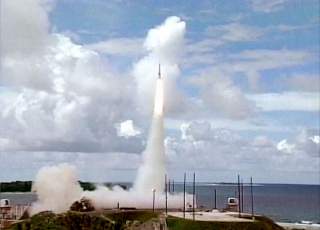Taking out a Nuke: Just How Good Are America's ICBM Defenses?
Could it be done?
Key point: Washington has successfully shot down an ICBM before. However, there are good reasons to doubt that this can be done multiple times in a real war.
The U.S. Missile Defense Agency (MDA) on March 25, 2019 claimed it successfully intercepted an ICBM-class target rocket during the first-ever "salvo" test of the U.S. Army's Ground-Based Midcourse Defense missile system.
The test comes two years after the MDA for the first time claimed to intercept an ICBM-like rocket using the GMD system. There were reasons to be skeptical of the agency's 2017 claim. Likewise there are reasons to doubt the 2019 test was as successful as the military insisted it was.
The target rocket blasted off from the Reagan Test Site on Kwajalein Atoll in the Pacific Ocean. Space, ground- and sea-based sensors tracked the target. Four thousand miles away, missileers at the GMD site at Vandenberg Air Force Base in California launched two 50-feet-tall GMI missiles.
Kill vehicles separated -- in essence, non-exploding warheads -- separated from the GMI missiles and broke free of Earth's atmosphere. There at the edge of space, the kill vehicles reportedly met the incoming target rocket.
"This test was the first salvo engagement of a threat-representative ICBM target by two Ground Based Interceptors, which were designated GBI-Lead, and GBI-Trail for the test," the Missile Defense Agency stated.
The GBI-Lead destroyed the reentry vehicle, as it was designed to do. The GBI-Trail then looked at the resulting debris and remaining objects, and, not finding any other reentry vehicles, selected the next 'most lethal object' it could identify and struck that, precisely as it was designed to do."
"This was the first GBI salvo intercept of a complex, threat-representative ICBM target, and it was a critical milestone," MDA director Samuel Greaves stated. "The system worked exactly as it was designed to do, and the results of this test provide evidence of the practicable use of the salvo doctrine within missile defense."
But Laura Grego, a missile expert with the Massachusetts-based Union of Concerned Scientists, is skeptical. "The test was really secretive, much more so than in past years," Grego told National Public Radio. "It was called a success, but we can't tell from public information how high the bar for success was set."
The same lack of transparency plagued the 2017 test. MDA declined to specify how fast the target was traveling in that test. The high speed of a true ICBM is one of the main reasons that class of rocket is so hard to intercept. An intercontinental-range missile can travel as fast as 20 times the speed of sound.
In the days prior to the 2017 trial, Grego examined the distances the two test rockets were expected to travel—and how quickly they would do so—and concluded that the MDA's target rocket would probably be significantly slower than an ICBM would be.
If it's true that the Pentagon tests its missile-defenses against slower targets than is realistic, then the military doesn't really know if the defenses truly work. The GMD system is the only U.S. missile-defense that is supposed to be able to hit ICBMs.
The GMD missile "shield" includes 40 operational interceptor missiles at Fort Greely in Alaska and four at Vandenberg. The Pentagon plans to add another 20 GMI rockets over the next few years.
But Grego cautioned against placing too much faith in the system. "We should not be thinking about the GMD as a robust defense or a robust deterrent," she told NPR. "It does not provide protection in a real-world sense."
Despite lingering doubts about the effectiveness of existing missile-defenses, the military plans to add new and equally unproven system to the U.S. missile shield. The U.S. Navy announced in early 2019 that it soon would test its SM-3 missile-interceptor against an ICBM-class target.
The SM-3 test could face the same challenges that have complicated the GMD trials. The target rocket must fly as fast as a true ICBM does in order to the test to have any merit.
Russia, for one, isn't taking any chances. In 2018 Russian president Vladimir Putin rushed development of the Kremlin's new hypersonic Avangard nuclear missile, a Mach-20 glider that travels lower than an ICBM does, potentially foiling missiles such as the SM-3 and GMD, which are designed to work at very high altitudes.
This first appeared in 2019.
Image: Reuters

